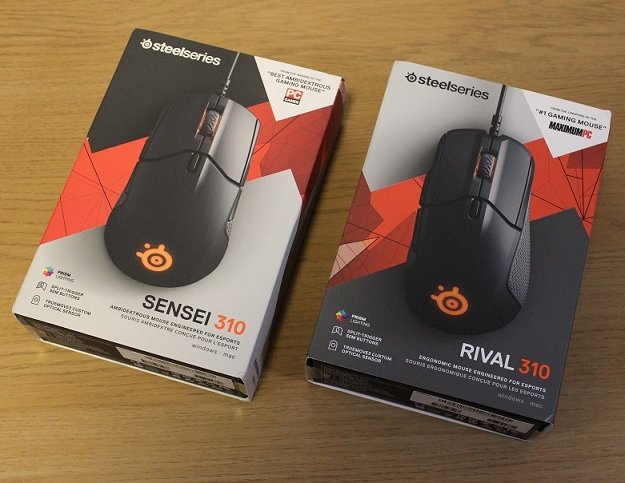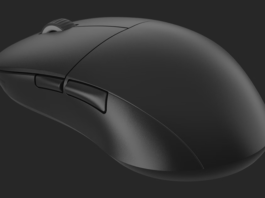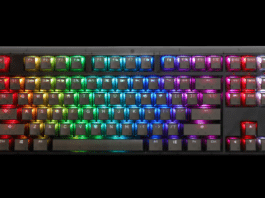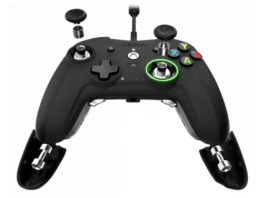Introduction & Specification
Ugh, I suppose I had better take a break from PUBG and do this review.
Hey everyone, I am back again with a review of not one but two mice! Steelseries, who I am pretty sure the vast majority of you have heard of and experienced their products, have been around for ages. They supply Keyboards, Mice and Headsets for the most part and have a reputation for creating quality products.
DOUBLE TROUBLE: Today Steelseries present us with two mice based on the same 310 platform returning with a fond favourite form with the Sensei alongside their big hitter the Rival design.
I don’t know what a 310 is so here’s a spec list.
Steelseries Sensei 310
Sensor
- Sensor Name: SteelSeries TrueMove3
- Sensor Type: Optical
- CPI: 100-12000, 100 CPI Increments
- IPS: 350+, on SteelSeries QcK surfaces
- Acceleration: 50G
- Polling Rate: 1 ms
- Hardware Acceleration: None (Zero Hardware Acceleration)
Design
- Top Material: Finger Print Resistant Semi-Rough Matte
- Core Construction: Fiber-Reinforced Plastic
- Shape: Ambidextrous
- Grip Style: Claw or Finger-Tip
- Number of Buttons: 8
- Switch Type: Omron Mechanical Rated For 50 Million Clicks
- Illumination: 2 RGB Zones, Independently Controlled
- Weight: 92.1g
- Length: 125.1mm
- Width: 60.77mm (front), 61.77mm (middle), 70.39mm (back)
- Height: 38.95mm
- Cable Length: 2m, 6.5ft
Compatibility
- OS: Windows, Mac, and Linux. USB port required
- Software: SteelSeries Engine 3.10.12+, for Windows (7 or newer) and Mac OSX (10.8 or newer)
Box Content
- Product Information Guide
- Sensei 310 Gaming Mouse
Steelseries Rival 310
Sensor
- Sensor Name: SteelSeries TrueMove3
- Sensor Type: Optical
- CPI: 100-12000, 100 CPI Increments
- IPS: 350+, on SteelSeries QcK surfaces
- Acceleration: 50G
- Polling Rate: 1ms
- Hardware Acceleration: None (Zero Hardware Acceleration)
Design
- Top Material: Finger Print Resistant Semi-Rough Matte
- Core Construction: Fiber-Reinforced Plastic
- Shape: Ergonomic, Right-Handed
- Grip Style: Palm or Claw
- Number of Buttons: 6
- Switch Type: Omron Mechanical Rated For 50 Million Clicks
- Illumination: 2 RGB Zones, Independently Controlled
- Weight: 88.3g
- Length: 127.6mm
- Width: 57.16mm (front), 62.07mm (middle), 70.1mm (back)
- Height: 41.98mm
- Cable Length: 2m, 6.5ft
Compatibility
- OS: Windows, Mac, and Linux. USB port required
- Software: SteelSeries Engine 3.10.12+, for Windows (7 or newer) and Mac OSX (10.8 or newer)
Box Content
- Product Information Guide
- Rival 310 Gaming Mouse
A Closer Look
Good solid Steelseries packaging greets us on arrival, box shading and name colour the main difference noticed before seeing the shapes, It’s one way to help tell them apart. A nice picture of each mouse and some features displayed here. 
Over on the nice flat underside there are more features and specs in various languages, a diagram also highlights which mouse you are looking at by greying out the other option.
I actually really like the way the 310 mice are presented when the box is opened, sufficiently cushioned but really easy to extract from packaging, no crackling plastic blister packing here with wires annoyingly fed through holes, yeah you peripheral manufacturers must know it gets on people’s nerves when you have the thread through the whole wire. Here the cable just rests in a slit and is easily extracted.
Steelseries Rival 310
I am going to let the Rival 310 go first, because, well that’s the order the photos were in on my camera. Box contents aren’t much to write home about, one cabled mouse and a manual.
Looking at the rear of the Steelseries Rival 310 we see a familiar form, not just in the Rival but with an old friend the Intellimouse from Microsoft. My memory might be failing me but I think I recall something about the company that Steelseries once was having a major role in the Intellimouse. Anyway, we have a plastic top coating that features what I would call a light grit, pretty much the same texture as my favourite keycap material.
The left hand side of the Rival greets us with some rubber grippy material that has a nice texture to it, along with two well-sized, well-placed buttons: I have no complaints here.
No buttons to greet us over on the right hand side, that same rubber grippy surface is there, this mouse is of course not even trying to cater to left handed users, Steelseries have an answer for that little problem.
The front of the rival is sleek and functional, the main buttons are separate from the main housing unlike many mice these days that choose to create a sleeker all-in-one design. The mouse wheel has an interesting tread on it which doesn’t directly correspond to notches in the wheel operation. Finally we have a dpi switch just behind the main buttons, this allows you to switch between the two configurable dpi profiles available.
Underneath the mouse we have some replaceable teflon pads, notice the notches where you can get a fingernail under to help remove them, nice. A hole with a sensor in it, an embossed Steelseries logo and a device label are all that remains to be seen. Nothing fancy going on under here but why would there be? I only wave the underside of my mouse around when gesticulating after performing badly in games. That Intellimouse style is very much here too.
Plugged in the RGB lighting kicks in, front and rear lights are independent of each other, this is all accomplished within the software.
Steelseries Sensei 310
You might recall I mentioned earlier in the review that Steelseries had an answer to the right handed bias of the Rival, well here it is, the truly ambidextrous Sensei 310. You get all the same internal specs of the Rival 310 but with a different housing and button configuration.
Now I am very familiar with this shape, as a previous owner of a Sensei Raw, I recall a comfortable design. The big difference here is the plastic top coating rather than the slightly rubberized coating of the Raw, again we get the light grit coating as with the Rival.
The Sensei 310 again uses the same rubber grip material as the Rival however here the buttons are smaller, still just as easy to reach though.
The right side of the Sensei is a mirror of the left, trust me I didn’t just flip the image. Steelseries are giving left handed users the exact same experience as right handed users of this mouse.
The front view of the Sensei gives us larger buttons than the rival as they fill further out to the edges, otherwise its the same design of scroll wheel and dpi button.
Underneath we have a very similar layout to the Rival with the Sensei however it is more symmetrical and the replaceable teflon pads are more evenly spaced out to allow the same experience no matter which hand you use.
Plugged in we again get two zone illumination which is of course configurable to match your mood, even if you wish to turn it off.
Steelseries Engine 3 Software
The Steelseries Engine software has been around a long time, I have used it for years, as you can see from my device selection it remembers even the oldest of devices I own or owned.
The configuration pages for both the Rival 310 and the Sensei 310 are almost identical. They cater for fine tuning dpi’s, you can even enter your own desired number anywhere from 100 to 12000 dpi which is an impressive range and more than caters for the majority of users’ needs be it in gaming or productivity. Each mouse button is configurable along with various settings for the two RGB lighting zones. Further down on the right there are variable settings for Acceleration, Angle Snapping and a Polling rate which goes from 125 to 1000 to further enable fine tuning.
As with many mice at this level, a decent macro system is available for those that like to use them.
Performance & Testing
So I am only going to split the review on the two 310 Steelseries mice here where it makes a difference, they have the same technical spec underneath the hood.
General Use
So for everyday usage, the mouse is spot on. The mice are both very comfortable to use, I actually found that with this sensor I lowered my typical favoured 1800 dpi to 1400, it just felt better going about my day-to-day Windows usage. This could be as a result of a more accurate sensor, but we know what will show that up, besides image and music apps which for the record show the mouse to be very calm and accurate when cropping and editing.
Gaming
Well not to shout out too much but this is a very pleasant experience, playing a few FPS games as I do such as CS:GO and Playerunknown’s Battlegrounds, I am definitely seeing an improvement in my accuracy, I spent well over a week switching between both mice and noticed a constant improvement in accuracy as opposed to the placebo effect of using something new. The disclaimer here is that my aim is bad and I should feel bad, this does not reflect on the mouse. The mouse glides across the mat and the TrueMove3 sensor more than does its job. Comfort wise I actually preferred the Rival 310 as it fit my hand a little better, I tend to raise the middle of my palm when using the Sensei 310 but both were really comfortable to use over long gaming sessions. This is an excellent gaming mouse.
Conclusion
So Steelseries have sent us two mice the Sensei 310 and the Rival 310, ensuring that at this level they are catering for the entire audience of peripheral users.
Performance
What can I say, the 310 sensor never missed a beat, the configurable DPI settings are highly tunable and the mice would sit just as well on a productive office desk as they would on the mousemat of a tournament gamer. The build quality is of a high standard and should last through long term heavy use. The configurable and reliable software is easy to use and is laid out in a sensible fashion.
Design
Two designs catering for just about every mouse user out there, the comfort level of these mice is excellent, the shape and location of the buttons uses a formula that is tried and tested and just works. The materials are a little different to what I have been used to lately but they are pleasant to the touch and assist with overall comfortable usage. The cable is not braided which is unusual at this price point, I think this just points to more work going into the actual mouse. The lighting is completely configurable so the appearance can be as understated or bright as the user wishes.
Value
So at around £60 at the time of writing, this mouse is not for the budget minded, but anyone serious about their peripherals and with this kind of money to spare would not be disappointed. Steelseries have here produced a pair of great mice catering to both left handed and right handed users and should these devices ever go on sale below £45 the competition will really have something very serious to try and counter.
Final Thoughts
Steelseries have launched a serious onslaught on the £50+ mouse marketplace with a pair of very well designed and extremely competent performers in the Rival 310 and the return of the Ambidextrous Sensei 310. Solid build quality, comfortable design and just about flawless performance from the new TrueMove3 sensor, it is very easy to award both these mice our Platinum Award to go with five stars across the board. Visiting friends who were fortunate to experience them are already placing orders.
Well done Steelseries.
-
Performance
-
Design
-
Value
Summary
Pros
-Fantastic well built designs
-Ambidextrous option
-Great performance
-Comfortable
Cons
-Maybe a little expensive for some
























